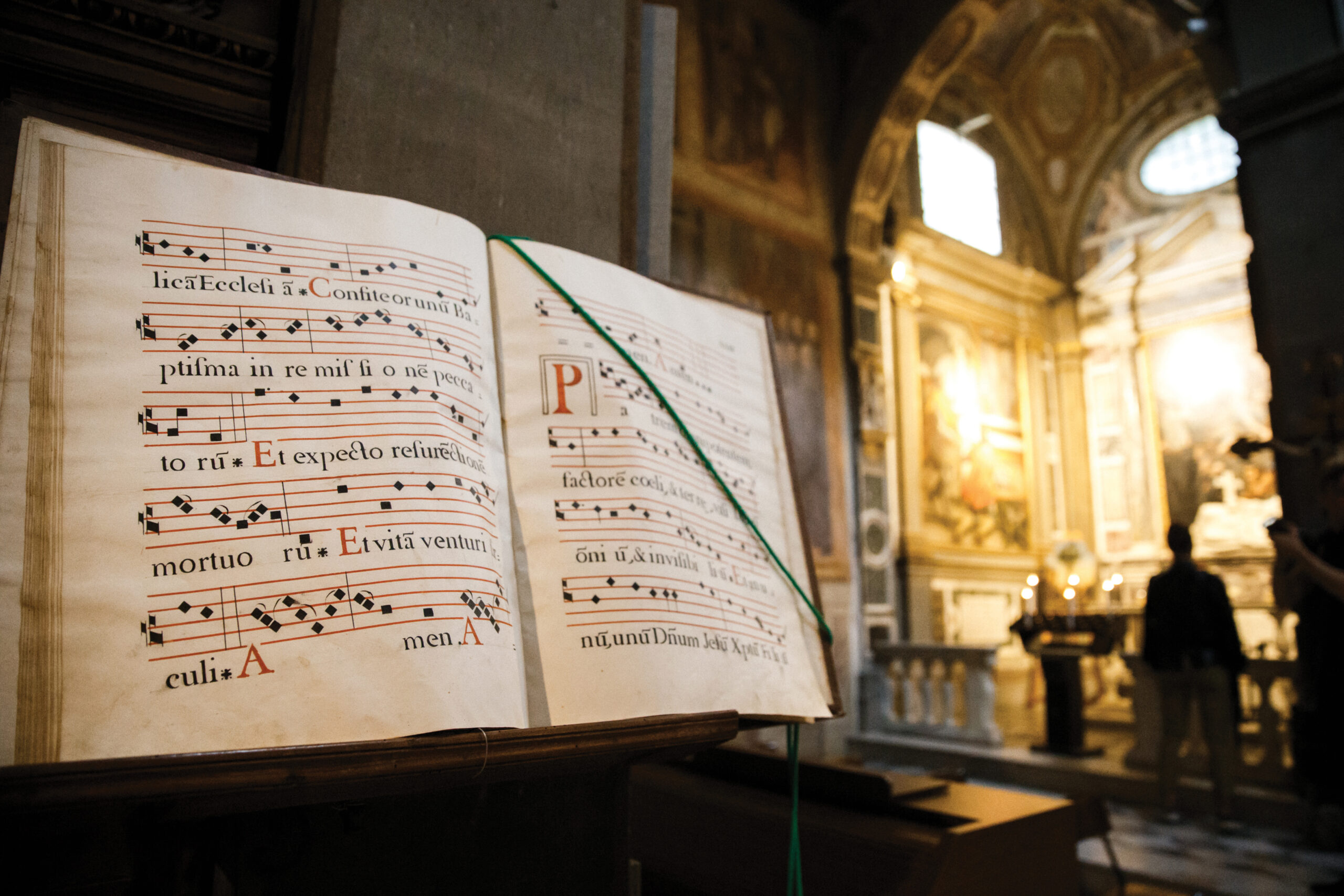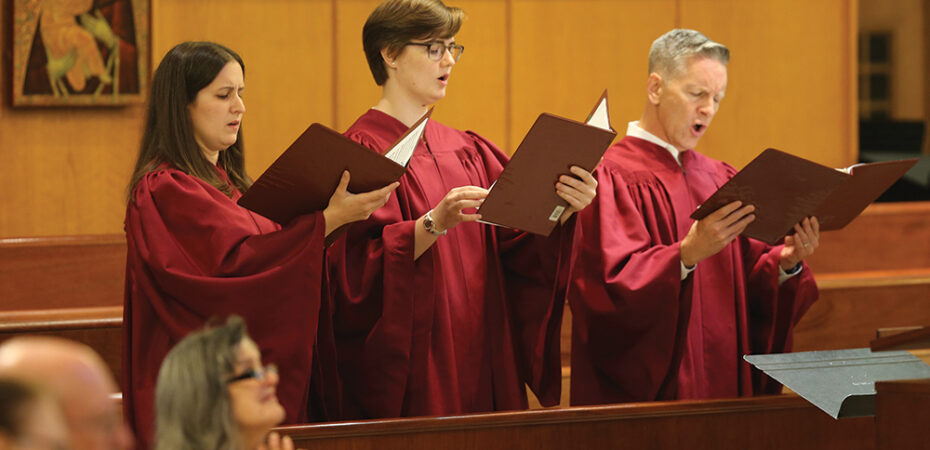What Exactly Is Gregorian Chant?
Five responses to broaden understanding of chant’s place in Catholic liturgy
Father Stephen Concordia Comments Off on What Exactly Is Gregorian Chant?
Gregorian chant and its place in Catholic liturgy, sad to say, are still causes of debate, if not division, in our Church. But what exactly is Gregorian chant? I hope to offer some of the less commonly known answers to the question.
1. A substantial musical repertory of great variety.
Gregorian chant is a collection of approximately 2,000 melodies with texts in Latin, virtually all biblical texts, drawn predominantly from the Book of Psalms. The origins of these melodies have been studied extensively and though there are still some gaps here and there, a consensus of scholars would affirm the following sketch of how it came to be. What we now call Gregorian chant is the result of an artful combination of two preexisting repertories: Old Roman chant and Frankish chant. Why the combination? From the fourth century, the expansion of the Church had established numerous and, in part, autonomous ecclesiastical centers. Many of these centers developed their own liturgical rites, along with their own liturgical chant. In Italy alone, for instance, there were the Roman, the Milanese, the Beneventan and the Acquilean chant repertories. In Spain, the Mozarabic rite had its chant. Moving north would be found the Celtic and Gallican traditions
During the Carolingian Renaissance (eighth to ninth centuries) began the cultural/political movement to unite these various centers and, ultimately, form the Holy Roman Empire under the emperor, Charlemagne. The Roman liturgy, together with its chant, was adopted as the official one of the empire, and all others were to be suppressed. However, a compromise was made with the merging of the Old Roman and the Frankish chant, which is the chant that has come to be called Gregorian.
It is said that the merging was completed in the eighth and ninth centuries. These, however, are the dates when the very first manuscripts of the “new” repertory appear in musical notation. Perhaps the most amazing fact about this repertory is that it had been “composed” before the invention of musical notation, in the period known as the “oral tradition.”
It is significant to note, too, that the creation of all the above repertories occurred together with that of the liturgy — that is, the evolution of the liturgy called forth new liturgical musical forms.

2. A repertory of liturgical-musical forms.
Every Gregorian chant is a liturgical-musical form because its creation had to serve and support a specific liturgical element: the schola’s introit that colors and opens the celebration; the celebrant’s solemn orations, answered by the assembly’s powerful choral affirmations; and again their joyful responsorial refrains, the deacon’s confident proclamation of the Gospel of the feast, etc.
The chant repertory falls into two large categories: chants for the Mass, and those for the Divine Office. The origins of these two categories, geographical and chronological, are very different, with their own history. To these two categories must be added the subdivision of the chants for the Mass: the Ordinaries and the Mass Propers. The Ordinaries include the Kyrie, Gloria, Sanctus and Agnus Dei. These are rather few and virtually all are in syllabic genres — that is, a style in which every syllable of the text receives but one note. The Mass Propers — Introit, Alleluia, Offertory, Communion — were composed for the schola. Some of these — the Alleluias and the Graduals — are in the ornate genre. The melodies in the ornate genre contain very elaborate, virtuosic melismas and were composed for soloists. Still others, the Introits and Communions, are in semi-ornate genre. These are poetic in style and contain a blend of shorter ornaments, and bear such similarity to one another as a melodic genre as to give credence to the theory they were all composed for the same schola, at the same time and place.
3. A unique style of vocal music.
Gregorian chant is a style of vocal music known as monody — that is, it consists of a single melodic line. Even when sung by a choir, the many voices all sing the one identical melody. This may be the characteristic of Gregorian that most contrasts with the music of our own times. With chant there is no accompaniment, no rhythm section, no added harmonies or “filling in.” Modern ears might react by claiming, “There’s nothing going on.” There is plenty going on, but our ears are unprepared for listening to such simple, concentrated, unpretentious singing, where there is nothing to detract from the words, nor to overwhelm the actions of the liturgy.
Recent and important research on Gregorian style has clarified the relationship of the Latin text to the Gregorian melody. Simply put, the melody and the words seem to be “made for one another.” To illustrate: In Latin prose, every Latin word has one, and only one, accented syllable. When that syllable is spoken, it is pronounced at an elevated pitch. In contrast, the syllables before and after the accented one are pronounced with a lower pitch. In spoken Latin, these changes in intonation (higher, lower) are not grossly exaggerated, but they are said to be necessary, and without them there would be no prosody. A famous statement by Cicero reads, “Every word (in prose) has a kind of hidden melody.”
The melodies of Gregorian chant always treat the syllables in this way. The accents of the words are melodically higher, and the unaccented are lower. Naturally, the Gregorian melody is a work of art, and not the result of a slavelike adherence to abstract rules. What is important to singers of Gregorian chant is recognizing and appreciating how the sound of the words never conflicts with the melody.
4. The foundation of Western music.
The attributes of Gregorian chant that might contribute to this special distinction are many. The one I wish to point out is the frequency of quotations of Gregorian melodies by great composers throughout the history of music.
The earliest known forms of polyphony consisted of the improvised addition of tones above or below a Gregorian melody.
At the 12th-century School of Notre Dame, early polyphonic masters Leonin and Perotin created “organum,” which were elaborate polyphonic compositions built upon a cantus firmus that consisted in the elongated tones of a Gregorian melody.
Throughout the Renaissance, polyphonic composers similarly gave homage to Gregorian chant melodies in “tenor” Masses. A famous example is the “Missa Ecce Sacerdos Magnus” of Palestrina, who quotes the Gregorian antiphon Ecce sacerdos magnus.
Even as the style changed, the Baroque period continued this practice of quoting Gregorian melodies, while adding more instruments to accompany the singing. Famous examples include the psalm setting “Dixit Dominus” of George Frideric Handel for double choir, soloists and orchestra. Considered Handel’s first true masterpiece, it features a brilliant quotation of the Gregorian psalm tone, associated with the psalm that begins with the words Dixit Dominus (Psalm 110 / Vulgate 109).
Franz Liszt’s piano Concerto Totentanz (“Dance of Death”) is a bombastic elaboration on the Gregorian Funeral Sequence, the “Dies Irae,” and is the Romantic period’s homage to the Gregorian melody. Composers continue quoting chant in their compositions, to this day, as well as being inspired and influenced by its style — a prominent example is Estonian composer Arvo Pärt.
5. Finally, what exactly is Gregorian chant today?
“Gregorian chant is the ‘chant of the Word’ of the liturgies of the Roman Church, but not just any word, created by human beings, but of the Word of God … the chant of the Verbum, who in the fullness of time took on human appearance: ‘In the beginning was the Word, and the Word became flesh’” (Jn 1:1, 14).
The primary function of Gregorian chant is to be the vehicle by which the Verbum communicates with his people.
FATHER STEPHEN CONCORDIA, OSB, is a monk and priest of Saint Vincent Archabbey in Latrobe, Pennsylvania.
…………………………………………………………………………………………………………………………………………….
POPE ST. JOHN PAUL II AND PROMOTING DECORUM
In his papacy, Pope St. John Paul II emphasized the importance of incorporating sacred music in liturgy. He wrote in the “Chirograph of the Supreme Potiff John Paul II for the Centenary of the ‘Motu Proprio’ Tra Le Sollecitudini on Sacred Music”:
“Among the musical expressions that correspond best with the qualities demanded by the notion of sacred music, especially liturgical music, Gregorian chant has a special place. The Second Vatican Council recognized that ‘being specially suited to the Roman Liturgy’ it should be given, other things being equal, pride of place in liturgical services sung in Latin. St. Pius X pointed out that the Church had ‘inherited it from the Fathers of the Church,’ that sh
e has ‘jealously guarded [it] for centuries in her liturgical codices’ and still ‘proposes it to the faithful’ as her own, considering it ‘the supreme model of sacred music.’ Thus Gregorian chant continues also today to be an element of unity in the Roman Liturgy.
“Like St. Pius X, the Second Vatican Council also recognized that ‘other kinds of sacred music, especially polyphony, are by no means excluded from liturgical celebrations.’ It is therefore necessary to pay special attention to the new musical expressions to ascertain whether they too can express the inexhaustible riches of the mystery proposed in the liturgy and thereby encourage the active participation of the faithful in celebrations” (No. 7).
………………………………………………………………………………………………………………………………………………





